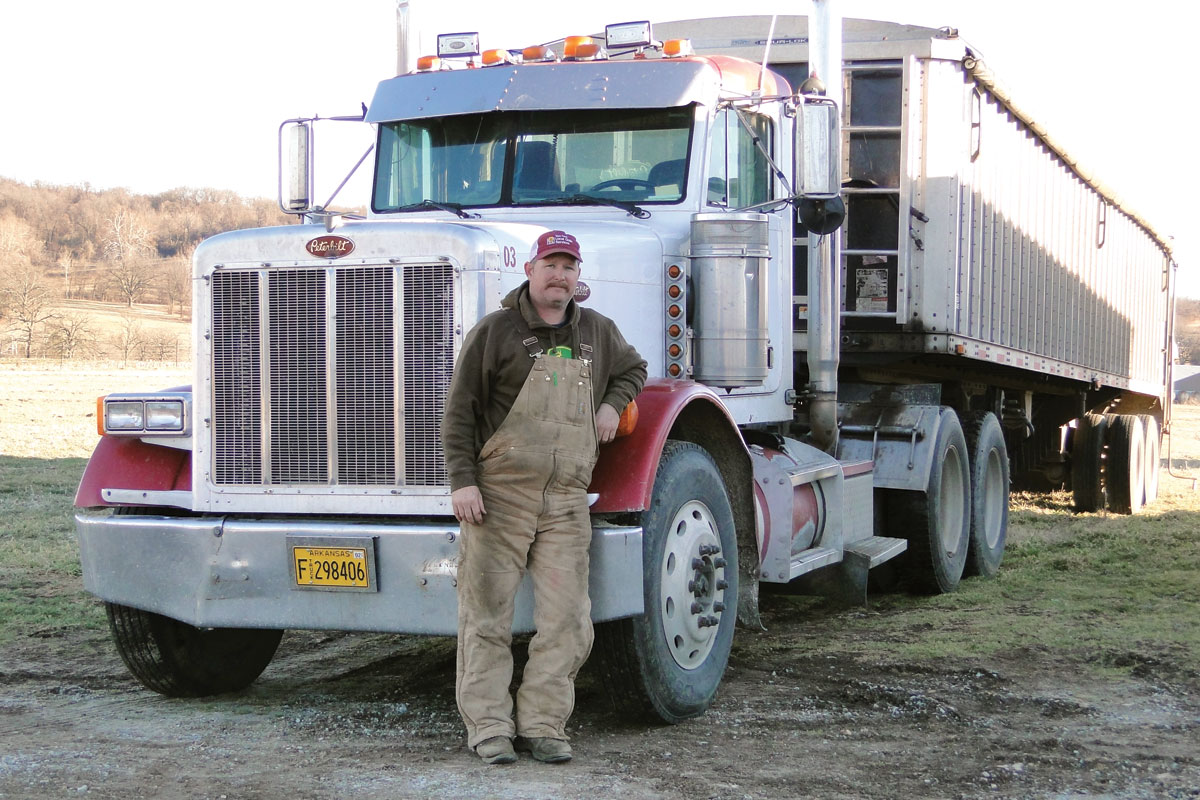
Allen Moore says crops, just like cattle, need careful management to be profitable
Allen and Cindy Moore of Lincoln, Ark., lease 800 acres of crop land, where they raise corn, a hay blend and soybeans double cropped with wheat.
“We use lease land because buying is cost prohibitive,” Allen said. “In addition, the distinct possibility that land in our area will be sold for housing developments sometime in the future may well be part of the relentless urban sprawl invading this corner of Arkansas.”
Allen has a lifetime history with agriculture, in terms of both livestock and crops. When his grandfather Glenn Moore passed away, a then 11 year-old Allen added driving a tractor to his chores in order to help his father Ralph pick up the slack. When Allen and Cindy married, Allen was in the commercial cattle business with his father and brother Curtis. Starting in 2008, they had grown silage to feed weaned calves from a herd with 200 mommas. Then, in 2012, the three decided to switch. Allen moved to crops while Ralph and Curtis went into the chicken business. Consequently, they sold the cattle while the market was high. As Allen often did, in preparation he sowed some acreage into wheat to serve as winter forage. The difference was that after the cattle were sold during that winter, the wheat was allowed to mature and then harvested in June and sold as grain to local chicken companies.
Land, whether leased or owned, needs careful management to be productive. A crop farm, just like a cattle ranch, needs to protect the land with a nutrient management plan while maximizing profits through best and value-added practices. What this means in terms of the Moore farm is that each crop has its own land management protocols. One of the biggest challenges in the industry is constantly evolving weed resistance to chemicals, very similar to the antibiotic resistance in medicine.
“Science and chemistry are the best recent advancements in the crop farming industry,” Allen said. “Years ago Roundup ready seeds were the solution. Then some weeds such as pigweed became resistant, so 10 to 15 years ago Liberty developed soybean varieties prepared for a different weed control product. Now a 3-year-old product called Diacambia has targeted the pigweed issue once again as the pigweed and others mutate to survive chemical control just the way bacteria mutate to survive antibiotics.”
Soybeans, Allen’s largest crop, is planted after wheat harvest with Liberty seeds and harvested in September through November. The land is sometimes fertilized in the spring with chicken litter and sometimes with a bio-solid byproduct fertilizer purchased from municipalities. Liberty Link supplies weed control. The harvested beans go to river ports, usually Catoosa, Okla., where they are barged down river and typically sent to China rather than to a crusher plant for protein extraction as frequently happens with northern soybeans lacking river access.
After harvest, the soybean stubble is baled and provided 500 bales last year. The bales are sold to a dairy farmer as part of a dairy mix and to other customers who use it as road and construction mulch. Allen is also looking toward a new and growing customer base where the material will be used as bedding. One advantage of baling the stubble is that the ground is more wheat receptive, which means higher yields.
Wheat is planted after the beans are harvested in September and November, and then fertilized with nitrogen January through March. The wheat is harvested in June when it is either sold to local poultry companies or sent down river as the soybeans are.
Corn ground is fertilized with chicken litter before planting in April and then with liquid nitrogen while it’s growing. Several different varieties are planted for staggering harvest as a means of managing the harvest workload. The corn is Roundup ready and harvested in August. After harvest, the land is disked to allow winter seasoning to optimize spring seeding. Sometimes the stalks are baled, a practice Allen intends to expand for uses similar to those of the harvested soybean stubble.
The final crop is a hay blend comprised of mixed grasses with some Bermuda and a little volunteer clover. Hay is sold to a dairy and five beef producers. The hay land, typically providing three cuttings per year, is fertilized mostly with chicken litter and sprayed for weeds with changes in products as needed.
The use of chicken litter is well-planned. Ralph and Curtis have chicken houses. Most of Allen’s chicken litter, which he spreads himself, comes from his dad and brother. Years ago, he sold chicken litter and still sells some, depending upon his needs and the time of the year. In annual terms this means of selling litter at some points and purchasing it at others in order to maximize usage and profits and to meet the demands of the chicken companies.
“My semi is a multipurpose tool with different Aulick Industries trailers which I also sell as a sideline,” Allen said. “The use of the semi helps cut down on equipment expenses. I use a flatbed to move equipment and haul hay while I use a belt trailer for chicken litter and grain. I sometimes haul litter and grain myself and other times pays someone to haul it for me because of time constraints.”
As if the farming doesn’t keep Allen busy enough, he is highly active with his family. Cindy has worked at Arvest bank in West Fork since 2001 and is a loan officer. The couple has three children: Cameron, 16; Kipton, 7; and Hudson, 3.
Allen also believes involvement in the agriculture community is important. He is a member of the Farm Bureau Board, the Washington County Fair Board, and the Van Buren Farmers Co-Op Board.
“Being part of the development of the agricultural community is critical. In addition, you can learn from everyone if you are willing to take the time to listen. I want to make our farm the best it can be with the hope that years from now my kids will be interested in agriculture so we can expand our farm,” Allen said.






